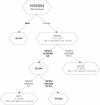Association of TNFSF4 (OX40L) polymorphisms with susceptibility to systemic sclerosis
- PMID: 19778912
- PMCID: PMC2927683
- DOI: 10.1136/ard.2009.116434
Association of TNFSF4 (OX40L) polymorphisms with susceptibility to systemic sclerosis
Erratum in
- Ann Rheum Dis. 2011 May;70(5):880
Abstract
Objective: It is increasingly being appreciated that multiple autoimmune diseases share common susceptibility genes. The tumour necrosis factor ligand superfamily member 4 gene (TNFSF4, OX40L), which encodes for the T cell costimulatory molecule OX40 ligand, has been identified as a susceptibility gene for the development of systemic lupus erythematosus (SLE). Accordingly, the aim of the current study was to investigate the possible association of the TNFSF4 gene region with systemic sclerosis (SSc), an autoimmune disease that leads to the development of cutaneous and visceral fibrosis.
Methods: A total of 9 single nucleotide polymorphisms (SNPs) in the TNFSF4 gene region, previously associated with susceptibility to SLE, were tested for association with SSc in a collection of 1059 patients with SSc and 698 controls.
Results: Case-control comparisons revealed a significant association between susceptibility to SSc and the minor alleles at SNPs rs1234314 (OR 1.20, 95% CI 1.04 to 1.4, p(FDR)=0.019), rs2205960 (OR 1.24, 95% CI 1.10 to 1.50, p(FDR)=0.019) and rs844648 (OR 1.16, 95% CI 1.01 to 1.30, p(FDR)=0.032). The minor allele at rs844644 was protective (OR 0.84, 95% CI 0.70 to 0.97, p(FDR)=0.038). Analysis of subsets of patients with SSc demonstrated significant associations of the TNFSF4 SNPs with limited and diffuse SSc as well as specific SNPs that were associated with SSc-associated autoantibodies. Finally, the analyses suggest a potential interaction between two TNFSF4 SNPs, rs2205960 and rs844648, with regards to SSc susceptibility.
Conclusions: Polymorphisms in the TNFSF4 gene region are associated with susceptibility to SSc and its clinical and autoantibody subsets. TNFSF4 may be another gene that confers risk to multiple autoimmune diseases.
Figures



References
-
- Concannon P, Rich SS, Nepom GT. Genetics of type 1A diabetes. N Engl J Med 2009;360:1646–54 - PubMed
-
- Onengut-Gumuscu S, Ewens KG, Spielman RS, et al. A functional polymorphism (1858C/T) in the PTPN22 gene is linked and associated with type I diabetes in multiplex families. Genes Immun 2004;5:678–80 - PubMed
Publication types
MeSH terms
Substances
Grants and funding
LinkOut - more resources
Full Text Sources
Other Literature Sources
Medical
Research Materials

